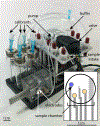Multianalyte Physiological Microanalytical Devices
- PMID: 28605606
- PMCID: PMC9235322
- DOI: 10.1146/annurev-anchem-061516-045334
Multianalyte Physiological Microanalytical Devices
Abstract
Advances in scientific instrumentation have allowed experimentalists to evaluate well-known systems in new ways and to gain insight into previously unexplored or poorly understood phenomena. Within the growing field of multianalyte physiometry (MAP), microphysiometers are being developed that are capable of electrochemically measuring changes in the concentration of various metabolites in real time. By simultaneously quantifying multiple analytes, these devices have begun to unravel the complex pathways that govern biological responses to ischemia and oxidative stress while contributing to basic scientific discoveries in bioenergetics and neurology. Patients and clinicians have also benefited from the highly translational nature of MAP, and the continued expansion of the repertoire of analytes that can be measured with multianalyte microphysiometers will undoubtedly play a role in the automation and personalization of medicine. This is perhaps most evident with the recent advent of fully integrated noninvasive sensor arrays that can continuously monitor changes in analytes linked to specific disease states and deliver a therapeutic agent as required without the need for patient action.
Keywords: biosensor; electroanalytical; microclinical analyzer; multianalyte physiometry; multielectrode arrays; multiplex.
Figures




References
-
- Bankar SB, Bule MV, Singhal RS, Ananthanarayan L. 2009. Glucose oxidase--an overview. Biotechnol Adv 27: 489–501 - PubMed
-
- Mross S, Pierrat S, Zimmermann T, Kraft M. 2015. Microfluidic enzymatic biosensing systems: A review. Biosens Bioelectron 70: 376–91 - PubMed
-
- Wang J. 2008. Electrochemical glucose biosensors. Chem Rev 108: 814–25 - PubMed
-
- Eklund SE, Taylor D, Kozlov E, Prokop A, Cliffel DE. 2004. A microphysiometer for simultaneous measurement of changes in extracellular glucose, lactate, oxygen, and acidification rate. Anal Chem 76: 519–27 - PubMed
Publication types
MeSH terms
Substances
Grants and funding
LinkOut - more resources
Full Text Sources
Other Literature Sources

